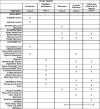Culturally tailored, peer-based sleep health education and social support to increase obstructive sleep apnea assessment and treatment adherence among a community sample of blacks: study protocol for a randomized controlled trial
- PMID: 30249293
- PMCID: PMC6154893
- DOI: 10.1186/s13063-018-2835-9
Culturally tailored, peer-based sleep health education and social support to increase obstructive sleep apnea assessment and treatment adherence among a community sample of blacks: study protocol for a randomized controlled trial
Abstract
Background: Compared to whites, blacks are at increased risk for obstructive sleep apnea (OSA) yet less likely to adhere to physician-recommended sleep assessment and treatment. Poor OSA health literacy and lack of social support to navigate the current healthcare system are two potential barriers to adequate OSA care. This study is designed to address these barriers by evaluating the effectiveness of a peer-based sleep health education program on adherence to OSA assessment and treatment among blacks at risk for OSA.
Method/design: In a two-arm, randomized controlled trial, we will ascertain the effectiveness of peer-based sleep health education and social support in increasing OSA evaluation and treatment rates among 398 blacks at low to high OSA risk. Participants at risk of OSA will receive quality controlled, culturally, and linguistically tailored peer education based on Motivational Enhancement principles over a period of 12 months. During this 12-month period, participants are encouraged to participate in a sleep home study to determine risk of OSA and, if found to be at risk, they are invited to undergo a diagnostic sleep assessment at a clinic. Participants who are diagnosed with OSA and who are prescribed continuous positive airway pressure treatment will be encouraged, through peer-based education, to adhere to recommended treatment. Recruitment for the project is ongoing.
Discussion: The use of a culturally tailored sleep health education program, peer health educators trained in sleep health, and home-based sleep assessment are novel approaches in improving OSA assessment and treatment adherence in blacks who are significantly at risk for OSA. Empirical evidence from this trial will provide clinical and population level solutions on how to improve and increase assessment and treatment of OSA among blacks.
Trial registration: NCT02427815 . Registered on 20 April 2015. ClinicalTrials.gov title: Sleep Health Education and Social Support Among Blacks With OSA.
Keywords: Blacks; Education; Home-study; Obstructive sleep apnea; Peer.
Conflict of interest statement
Authors’ information
All authors are faculty at New York University School of Medicine, 227 East 30th Street, 10016 New York, NY, USA.
Ethics approval and consent to participate
The trial was approved by New York University School of Medicine Institutional Review Board. All participants will sign a consent document in order to participate in this trial. The study reference number at NYU School of Medicine is i14-01028.
Consent for publication
Not applicable.
Competing interests
The authors declare that they have no competing interests.
Publisher’s Note
Springer Nature remains neutral with regard to jurisdictional claims in published maps and institutional affiliations.
Figures
Similar articles
-
Effectiveness of peer-delivered sleep health education and social support in increasing OSA evaluation among at-risk blacks.J Sleep Res. 2025 Feb;34(1):e14213. doi: 10.1111/jsr.14213. Epub 2024 May 21. J Sleep Res. 2025. PMID: 38773705 Free PMC article. Clinical Trial.
-
Tailored approach to sleep health education (TASHE): study protocol for a web-based randomized controlled trial.Trials. 2016 Dec 8;17(1):585. doi: 10.1186/s13063-016-1701-x. Trials. 2016. PMID: 27931249 Free PMC article. Clinical Trial.
-
Telephone-delivered behavioral intervention among blacks with sleep apnea and metabolic syndrome: study protocol for a randomized controlled trial.Trials. 2014 Jun 12;15:225. doi: 10.1186/1745-6215-15-225. Trials. 2014. PMID: 24925227 Free PMC article. Clinical Trial.
-
Perioperative Continuous Positive Airway Pressure Therapy: A Review With the Emphasis on Randomized Controlled Trials and Obstructive Sleep Apnea.Anesth Analg. 2021 May 1;132(5):1306-1313. doi: 10.1213/ANE.0000000000005480. Anesth Analg. 2021. PMID: 33857972 Review.
-
Optimal treatment of obstructive sleep apnea and excessive sleepiness.Adv Ther. 2009 Mar;26(3):295-312. doi: 10.1007/s12325-009-0016-7. Epub 2009 Apr 3. Adv Ther. 2009. PMID: 19337706 Review.
Cited by
-
Self-management behavior, associated factors and its relationship with social support and health literacy in patients with obstructive sleep apnea-hypopnea syndrome.BMC Pulm Med. 2022 Sep 18;22(1):352. doi: 10.1186/s12890-022-02153-1. BMC Pulm Med. 2022. PMID: 36115966 Free PMC article.
-
Photovoice for leveraging traditional, complementary, and integrative medicine amongst black adults to improve sleep health and overall health.Front Public Health. 2024 Jul 24;12:1359096. doi: 10.3389/fpubh.2024.1359096. eCollection 2024. Front Public Health. 2024. PMID: 39114505 Free PMC article.
-
The Need for Social and Environmental Determinants of Health Research to Understand and Intervene on Racial/Ethnic Disparities in Obstructive Sleep Apnea.Clin Chest Med. 2022 Jun;43(2):199-216. doi: 10.1016/j.ccm.2022.02.002. Clin Chest Med. 2022. PMID: 35659019 Free PMC article. Review.
-
Bringing Health Care Equity to Diverse and Underserved Populations in Sleep Medicine and Research Through a Digital Health Equity Framework.Sleep Med Clin. 2023 Sep;18(3):255-267. doi: 10.1016/j.jsmc.2023.05.009. Epub 2023 Jun 6. Sleep Med Clin. 2023. PMID: 37532367 Free PMC article. Review.
-
Effectiveness of peer-delivered sleep health education and social support in increasing OSA evaluation among at-risk blacks.J Sleep Res. 2025 Feb;34(1):e14213. doi: 10.1111/jsr.14213. Epub 2024 May 21. J Sleep Res. 2025. PMID: 38773705 Free PMC article. Clinical Trial.
References
-
- Kapur VK. Obstructive sleep apnea: diagnosis, epidemiology, and economics. Respir Care. 2010;55(9):1155–1167. - PubMed
Publication types
MeSH terms
Associated data
Grants and funding
LinkOut - more resources
Full Text Sources
Other Literature Sources
Medical
Miscellaneous





